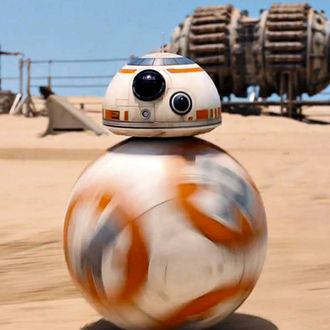
In one of the very first scenes fans saw from the new Star Wars film, a little orange droid clumsily rolls along a desert landscape in the teaser trailer for The Force Awakens. That spherical robot turned out to be named BB-8, and it has since been declared “the cutest droid in the universe.” People went nuts for the toy version the minute it was released; as our own Kyle Buchanan of Vulture phrased it, “The New Star Wars BB-8 Toy Is So Cute, I Nearly Lost My Mind.” The $150 toy from Sphero sold out on Amazon in less than 15 minutes, and as of Monday afternoon, both the East Harlem and Bronx Terminal Market locations of Target were sold out of the remote-controlled version. (Please don’t ask how I know this.)
What is it about BB-8 that makes it so freaking cute? As it turns out, the little robot is practically a textbook example of Kindchenschema, or baby schema, the reigning theory describing just what features it takes to make someone or something appear adorable. This is something that scientists have been theorizing about since at least the 1940s, when ethologist Konrad Lorenz introduced the concept in a landmark paper. In his words — quoted later in an essay by popular science writer Stephen Jay Gould — for a creature to be considered cute, it must have the following: “a relatively large head … large and low-lying eyes, bulging cheek region, short and thick extremities … and clumsy movements.”
BB-8 nails every one of these characteristics. Its “head” is relatively large in proportion to its spherical “body,” and its “eye” — the black eyepiece, rather — is also pretty huge when compared to the size of the head. The area surrounding either side of the eyepiece bulge out like chubby cheeks, and while it doesn’t exactly have extremities, its rounded lower half definitely adds to the chubby effect. When it moves, it bobs and wobbles a bit as it rolls, making it look a little bit clumsy. In short, it’s got everything required to be scientifically classified as a total cutie pie.
Its closest relation in the Star Wars universe is R2-D2, which is also pretty cute! But not quite as cute as BB-8. Artoo glides along on two flat treadmill-type “feet,” which makes him much too stable and competent-seeming to make him appear as endearing as BB-8. And it’s likely not an accident that a central droid character in the Star Wars films got cuter over time. In the 1970s, Gould examined the evolution of Mickey Mouse over the years and found that Mickey’s features became more babyish as the character aged, with his head and eye size growing ever larger over the cartoon’s then-50 years of existence. “Most Disney fans are aware of this transformation through time, but few (I suspect) have recognized the coordinating theme behind all the alterations — in fact, I am not sure that the Disney artists themselves explicitly realized what they were doing, since the changes appeared in such a halting and piecemeal fashion,” Gould wrote. Mickey’s facial characteristics became increasingly juvenile, and “babyish features tend to elicit strong feelings of affection in adult humans.”
Because this, as Lorenz argued, is the real point of Kindchenschema: Babies look helpless for their own good, in that it inspires the adults in their lives to take really good care of them. Though this theory was introduced in 1943, it wasn’t empirically tested until 2009, when researchers at the University of Pennsylvania and the University of Muenster showed undergraduates a series of photos of infants, asking them to rate the babies on cuteness (so harsh) and also asking them how motivated they would be to care for the baby. The cuter the babies, the more the students wanted to take care of them. But research has also shown that cuter creatures are considered more likable, and they tend to be looked at longer than their less-cute counterparts — important stuff for one of the star figures of a rebooted film franchise.
Beyond the Star Wars universe, our real-life robots are becoming markedly cuter by design, too, as the Verge reported last year. People tend to give the bots a break when they mess up — Aw, the little tyke, it’s still learning — and they also find them friendlier and more trustworthy, meaning they’re more willing to incorporate the robot into their lives. It’s no accident, in other words, that Google’s self-driving car is adorable, and the same goes for BB-8.




